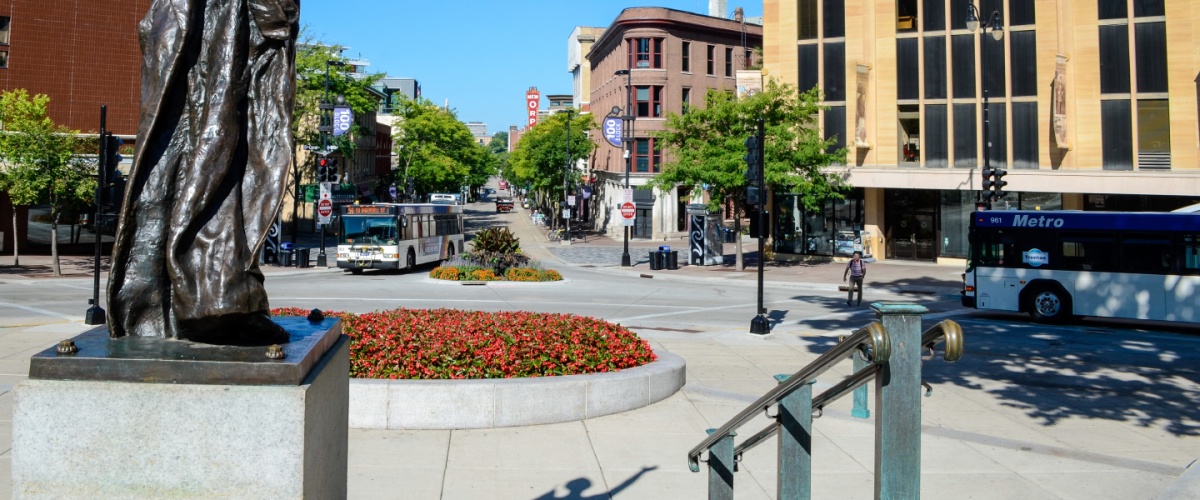
Environmental Review

Bus Rapid Transit Project Effects on Parks and Recreational Lands, Wildlife and Waterfowl Refuges and Historic Sites
The Federal Transit Administration (FTA) has evaluated environmental review documents submitted by the City of Madison for the proposed East-West Bus Rapid Transit project and found that the project meets the criteria for a National Environmental Policy Act (NEPA) categorical exclusion in accordance with federal laws.
These materials are posted below.
- East-West BRT Determination of Categorical Exclusion
- Appendix A – 30 Percent Plans
- Appendix B – Land Use and Zoning Technical Report
- Appendix C – Transportation Technical Report
- Appendix D - Service Plan Operations and Maintenance Cost
- Appendix E - Historic Cultural Resources
- Appendix F - Visual Quality Technical Report
- Appendix G - Noise Vibration Technical Report
- Appendix H - Acquisitions Technical Report
- Appendix I - Hazardous Materials Technical Report
- Appendix J - Social Community Disruption Technical Report
- Appendix K - Environmental Justice Technical Report
- Appendix L - Parkland Technical Report
- Appendix M - Wetlands Floodplain Water Quality Technical Report
- Appendix N - Endangered Species Technical Report
- FTA Documented Categorical Exclusion Approval Letter
- Errata Sheet
Background
In an effort to preserve publicly owned parks and recreation areas, waterfowl and wildlife refuges, and historic sites, Section 4(f) of the Transportation Act of 1966 established a requirement that federally-funded transportation projects, like the East-West BRT project, must consider impacts to these resources.
Parks and Recreational Lands in the East-West BRT Corridor
Construction of the 15-mile East-West Bus Rapid Transit (BRT) project would require temporary construction easements in three public greenspaces: Garner Park, Nautilus Point Park, and the Ice Age Junction Path. In addition, at Garner Park, a small strip of land would need to be permanently acquired to widen a bicycle and pedestrian trail. There are several other parks adjacent to the project where impacts are not expected. Overall, the introduction of BRT to the corridor is expected to enhance access to parks and trails.
The East-West BRT Project is expected to have two types of impact on public parks:
- Permanent incorporation: Part of the property is permanently incorporated into the transportation project, as at Garner Park.
- A permanent incorporation is de minimis if there would be no adverse effect on the activities, features or attributes that qualify the park for Section 4(f) protection. This is the case at Garner Park.
- Temporary occupancy: The property is not permanently incorporated into a transportation facility, but is required for construction-related activities, as at Ice Age Junction Path, Nautilus Point Park, and Garner Park.
- A temporary occupancy is a use if there is an adverse effect on the activities, features or attributes that qualify the park for Section 4(f) protection. This is not the case at Ice Age Junction Path, Nautilus Point Park, or Garner Park.
How Project Affects Each Park
- Breese Stevens Field
- Garner Park and Path
- Ice Age Junction Path
- Mineral Point Greenway/West Towne Soccer Fields
- Nautilus Point Park
- Reindahl (Amund) Park
- Starkweather Creek Bike Path
- Yahara River Parkway and Burr Jones Park
Historic Sites in the East-West BRT Corridor
Section 106 of the National Historic Preservation Act requires that federal agencies, in this case the Federal Transit Administration (FTA), identify and assess the effects the construction and operation of the East-West BRT project may have on historic properties. Under Section 106, FTA must consider public views and concerns about historic properties when making final project decisions.
The following four steps are required to fulfill Section 106 requirements:
- Initiate consultation by notifying the appropriate consulting parties. Consulting parties include, but are not limited to, the State Historic Preservation Officer (SHPO), interested tribes, local governments, and members of the general public with an economic, social or cultural interest in the project.
- Identify properties that may be affected by the project and determine if the property or properties are historic as determined by eligibility or listing in the National Register of Historic Places.
- Assess the effects of the project on the historic or cultural resource, in consultation with interested parties, and establish if they are adverse.
- Resolve adverse effects by developing and evaluating alternatives that could avoid, minimize, or mitigate these impacts on historic properties.
Learn More About the National Historic Preservation Act
Proposed Architecture/History Area of Potential Effects Memo
Section 106 Historic and Cultural Resources Consulting Parties Meeting
A meeting was held on Tuesday, September 14 to provide consulting parties with an opportunity to review the Area of Potential Effect, surveyed properties, and findings. It was also provided opportunity to review potential effects on historic properties.
Landmarks Commission Meeting
The survey report was provided to the Landmarks Commission for review and discussion. .
Public Comment
The East-West BRT project also requires conversion of parkland to transportation and includes construction in historic districts. Therefore the project must offer the public an opportunity to comment on these proposed changes. Public comments were collected through November of 2021..

